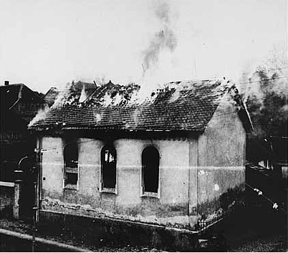 |
The burning of the synagogue in Ober Ramstadt. |
Today, the world knows that Kristallnacht was just the opening salvo – an ominous indication that death was coming to the Jewish people. But no one could have believed it would be a mass death of such historic proportions it is now immortalized as The Holocaust – the extermination of 6 million European Jews.
The following summary offers details of Kristallnacht and why the event and its aftermath still hold valuable lessons for contemporary mankind. These contemporary lessons will be addressed Friday, Nov. 11, in a special presentation by Bob Wolfson, executive director of the Plains States Region of the Anti-Defamation League (ADL)/Community Relations Committee of the Jewish Federation of Omaha since 1988. The presentation, which runs from noon to 1 p.m. in the University Tower Amphitheater (Room 4208), is sponsored by the medical center’s Employee Diversity Network.
 |
Bob Wolfson |
In the first half of 1938, numerous laws were passed restricting Jewish economic activity and occupational opportunities. In July 1938, a law was passed (effective Jan. 1, 1939) requiring all Jews to carry identification cards. On Oct. 28 of that year, 17,000 Jews of Polish citizenship, many of whom had been living in Germany for decades, were arrested and relocated across the Polish border. The Polish government refused to admit them so they were interned in “relocation camps” on the Polish frontier.
Among the deportees was Zindel Grynszpan, who had been born in western Poland and had moved to Hanover, where he established a small store, in 1911. On the night of Oct. 27, Zindel Grynszpan and his family were forced out of their home by German police. His store and the family’s possessions were confiscated and they were forced to move over the Polish border.
Zindel Grynszpan’s 17-year-old son, Herschel, was living with an uncle in Paris. When he received news of his family’s expulsion, he went to the German embassy in Paris, intending to assassinate the German Ambassador to France. Upon discovering that the ambassador was not in the embassy, he settled for a lesser official, Third Secretary Ernst von Rath. Rath was critically wounded and died two days later, on Nov. 9.
The assassination provided Joseph Goebbels, Hitler’s chief of propaganda, with the excuse he needed to launch a pogrom against German Jews. Grynszpan’s attack was interpreted by Goebbels as a conspiratorial attack by “International Jewry” against the Reich and, symbolically, against the Fuehrer himself. This pogrom has come to be called Kristallnacht, “The Night of Broken Glass.”
 |
Germans pass broken window of Jewish-owned shop. |
The official German position on these events, which were clearly orchestrated by Goebbels, was that they were spontaneous outbursts. The Fuehrer, Goebbels reported to Party officials in Munich, “has decided that such demonstrations are not to be prepared or organized by the party, but so far as they originate spontaneously, they are not to be discouraged either.”
Three days later, on Nov. 12, Hermann Goering called a meeting of the top Nazi leadership to assess the damage done during the night and place responsibility for it. Present at the meeting were Goering, Goebbels, Reinhardt Heydrich, Walter Funk and other ranking Nazi officials. The intent of this meeting was two-fold: to make the Jews responsible for Kristallnacht and to use the events of the preceding days as a rationale for promulgating a series of anti-Semitic laws which would, in effect, remove Jews from the German economy.
It was decided at the meeting that, since Jews were to blame for these events, they should be held legally and financially responsible for the damages incurred by the pogrom. Accordingly, a fine of 1 billion marks was levied for the slaying of Von Rath, and 6 million marks paid by insurance companies for broken windows was to be given to the state coffers.
Kristallnacht turns out to be a crucial turning point in German policy regarding the Jews and may be considered as the actual beginning of what is now called the Holocaust.
- By now it is clear to Hitler and his top advisors that forced immigration of Jews out of the Reich is not a feasible option.
- Hitler is already considering the invasion of Poland.
- Numerous concentration camps and forced labor camps are already in operation.
- The Nuremberg Laws are in place.
- The doctrine of lebensraum has emerged as a guiding principle of Hitler’s ideology. And,
- The passivity of the German people in the face of the events of Kristallnacht made it clear that the Nazis would encounter little opposition — even from the German churches.
Following the meeting, a wide-ranging set of Anti-Semitic laws were passed which had the clear intent, in Goering’s words, of “Aryanizing” the German economy. Over the next two or three months, the following measures were put into effect:
- Jews were required to turn over all precious metals to the government.
- Pensions for Jews dismissed from civil service jobs were arbitrarily reduced.
- Jewish-owned bonds, stocks, jewelry and art works can be alienated only to the German state.
- Jews were physically segregated within German towns.
- A ban on the Jewish ownership of carrier pigeons.
- The suspension of Jewish driver’s licenses.
- The confiscation of Jewish-owned radios.
- A curfew to keep Jews off the streets between 9 p.m. and 5 a.m. in the summer and 8 p.m. and 6 a.m. in the winter.
- Laws protecting tenants were made non-applicable to Jewish tenants.
- Perhaps to help ensure the Jews could not fight back in the future, the Minister of the Interior issued regulations against Jews’ possession of weapons on Nov. 11. This prohibited Jews from “acquiring, possessing, and carrying firearms and ammunition, as well as truncheons or stabbing weapons. Those now possessing weapons and ammunition are at once to turn them over to the local police authority.”
One final note on the Nov. 12 meeting is of critical importance. In the meeting, Goering announced, “I have received a letter written on the Fuehrer’s orders requesting that the Jewish question be now, once and for all, coordinated and solved one way or another.” The path to the “Final Solution” has now been chosen. And, all the bureaucratic mechanisms for its implementation were now in place.
Information above was taken from the Jewish Virtual Library, a division of the American-Israeli Cooperative Enterprise. Photos courtesy of the United States Holocaust Memorial Museum.